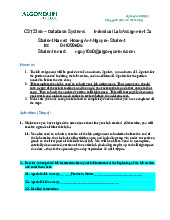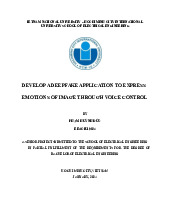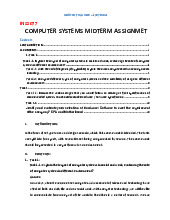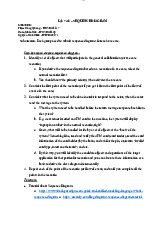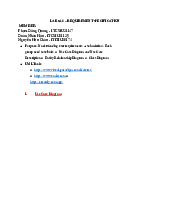



















Preview text:
VIETNAM NATIONAL UNIVERSITY – HOCHIMINH CITY INTERNATIONAL
UNIVERSITY SCHOOL OF ELECTRICAL ENGINEERING
DEVELOP A DEEPFAKE APPLICATION TO EXPRESS
EMOTIONS OF IMAGE THROUGH VOICE CONTROL BY PHẠM HUỲNH ĐỨC EEACIU19034
A SENIOR PROJECT SUBMITTED TO THE SCHOOL OF ELECTRICAL ENGINEERING
IN PARTIAL FULFILLMENT OF THE REQUIREMENTS FOR THE DEGREE OF
BACHELOR OF ELECTRICAL ENGINEERING HO CHI MINH CITY, VIET NAM JANUARY, 2024
DEVELOP A DEEPFAKE APPLICATION TO EXPRESS EMOTIONS
OF IMAGE THROUGH VOICE CONTROL BY PHẠM HUỲNH ĐỨC EEACIU19034
Under the guidance and approval of the committee, and approved by its members, this thesis
has been accepted in partial fulfillment of the requirements for the degree. Approved:
______________________________________ _ Chairperson
______________________________________ _ Committee member
______________________________________ _ Committee member
______________________________________ _ Committee member i
______________________________________ _ Committee member HONESTY DECLARATION
My name is Pham Huynh Duc, student ID: EEACIU19034. I would like to declare that, apart
from the acknowledged references, this senior project either does not use languages, ideas, or other
original materials from anyone; or has not been previously submitted to any other educational and
research programs or institutions. I fully understand that any writings in this senior report
contradicted to the above statement will automatically lead to the rejection from the EE program
at the International University – Vietnam National University Ho Chi Minh City.
@Pham Huynh Duc, 25/01/2024. ii TURNITIN DECLARATION
Name of Student: Phạm Huỳnh Đức
Student ID: EEACIU19034 Date: 25/01/2024 Student Name Advisor Name Pham Huynh Duc Nguyen Ngoc Truong Minh iii ACKNOWLEGMENT
It is with a deep gratitude and appreciation that I acknowledge the professional guidance of
Dr. Nguyen Ngoc Truong Minh, Head of Department of Telecommunications, School of Electrical
Engineering. His constant encouragement and support helped me to achieve my goal.
I would also like to express my gratitude to professors, staffs at International University
(VNU-HCMC) and School of Electrical Engineering. Their invaluable knowledge and guidance
supports me and provide me with the necessary skills and experience to complete my senior project. iv TABLE OF CONTENTS
HONESTY DECLARATION .......................................................................................................... i
TURNITIN DECLARATION ....................................................................................................... iii
ACKNOWLEGMENT .................................................................................................................. iv
TABLE OF CONTENTS ................................................................................................................. v
LIST OF TABLES ........................................................................................................................ vii
LIST OF FIGURES ..................................................................................................................... viii
ABBREVIATIONS AND NOTATIONS ......................................................................................... x
ABSTRACT .................................................................................................................................. xi
CHAPTER I INTRODUCTION ..................................................................................................... 1
1.1 Background ........................................................................................................................... 1
1.2 Goal and Objectives .............................................................................................................. 2
1.3 Structure of the report ........................................................................................................... 2
CHAPTER II DESIGN SPECIFICATIONS AND STANDARDS ................................................. 4
2.1 Design Specifications and Standards .................................................................................... 4
2.2 Realistic Contraints ............................................................................................................... 4
CHAPTER III PROJECT MANAGEMENT .................................................................................. 4
3.1 Budget and Cost Management Plan ...................................................................................... 5
3.2 Project Schedule.................................................................................................................... 5
3.3 Resources planning ............................................................................................................... 5
CHAPTER IV LITERATURE REVIEW ........................................................................................ 6 v
4.1 Facial Recognition and Attendance System using dlib and face_recognition libraries ........ 7
4.2 Generative Adversarial Networks: Introduction and Outlook .............................................. 7
4.3 GANimation: automatically-aware Facial Animation from a single image ....................... 11
4.4 A Voice Assistance Based News Web Application by using AI Tools ................................ 14
CHAPTER V METHODOLOGY ................................................................................................. 16
5.1 Training the model .............................................................................................................. 19
5.2 Processing fake video ......................................................................................................... 24
5.3 Using speech regconition package in python to analyze speech information .................... 26
CHAPTER VI EXPECTED RESULT ........................................................................................... 29
6.1 Training the model .............................................................................................................. 29
6.2 Processing fake video ......................................................................................................... 31
6.3 Using speech regconition package in python the analyze speech information ................... 34
CHAPTER VII CONCLUSION AND FUTURE WORK ............................................................. 37
7.1 Conclusion .......................................................................................................................... 37
7.2 Future work ......................................................................................................................... 39
REFERENCES .............................................................................................................................. 40 vi LIST OF TABLES
Table 1: Project sofware, tool and model specifications ....................................................... 4
Table 2: Realistic contraints of the project ............................................................................ 4
Table 3: Project schedule ....................................................................................................... 5 vii LIST OF FIGURES
Figure 1: Basic structure of Generative Adversial Network model [4] ................................. 8
Figure 2: Some of developed GAN structure [4] .................................................................11
Figure 3: Overview of approach to generate photo-realistic conditioned images [5]. ....... 12
Figure 4: Attention base generator [5] ................................................................................. 14
Figure 5: Flowchart 1, Overall Concept of the project ........................................................ 16
Figure 6: Flowchart 2, Video and speech processing .......................................................... 17
Figure 7: Flowchart 3, GAN algorithm in generate fake image .......................................... 18
Figure 8: Preparation data set celeba ................................................................................... 20
Figure 9: Face regconition with a rectangular boundary ..................................................... 20
Figure 10: comparision of individual step in this section .................................................... 21
Figure 11: Data processing and preparing for training ........................................................ 22
Figure 12: Data after processing .......................................................................................... 23
Figure 13: Trainning process in colab ................................................................................. 23
Figure 14: Au vector parameters extracted by Open Face Lab [11] .................................... 24
Figure 15: Creating a video by ffmp ................................................................................... 26 viii
Figure 16: Result of a dataset after operating ...................................................................... 29
Figure 17: Au vecter paramer of trainning image ............................................................... 30
Figure 18: data set after preparing and obtaining AU vector .............................................. 30
Figure 19: result pretrained model after trainning ............................................................... 31
Figure 20: User’s input imaga after processing ................................................................... 31
Figure 21: a set of fakes image after applying the model .................................................... 32
Figure 22: comparision the output result for each step .......................................................
33 Figure 23: a set of full context
image .................................................................................. 33
Figure 24: output of taking speech data .............................................................................. 34
Figure 25: Word splited from input sensetence ................................................................... 35
Figure 26: Emption function called(1) ................................................................................ 35
Figure 27: Emption function called(2) ................................................................................ 36
Figure 28: apply facial landmark to change face gesture .................................................... 37
Figure 29: Apply first order motion GAN to generate fake imagfe .................................... 38 ix
ABBREVIATIONS AND NOTATIONS API:
Application Programming Interface AU: Action Unit
CNN: Convolutional Neural Network CSS: Cascading Style Sheets EC: Emotion Control FAS: Facial Action System Generative Adversial Network GAN: x ABSTRACT
In our digital age, where we seek to make images more lifelike and filled with emotions, this
project introduces a user-friendly application. The application utilizes the deepfake technology to
create images that are both realistic and emotionally expressive.
The core innovation of this tender lies in its ability to enable users to input an image of a
person through voice commands, control the emotion of the image of the face. Whether conveying
happiness, sadness, excitement, or any other emotion, users can now authentically express their
feelings through digital avatars. The project’s technical foundation bases on advanced deepfake
algorithms, voice recognition, and real-time image processing. We explore the intricacies of these
technologies, ensuring seamless integration for users, making them more engaging and emotionally resonant.
By combining deep learning and voice control, we empower users to add genuine emotions
to images, offering a new dimension to visual expression. Also, we delve into the technical aspects
of deepfake technology, voice recognition, and real-time image manipulation to ensure an intuitive
and engaging experience. In general, our project present the application of technology to convey
emotions through images, making digital expression more relatable and immersive. xi lOMoARcPSD|47206417 CHAPTER I INTRODUCTION
In this section, we will discuss about the background, purpose of this application. Through
this project, we will also disscuss about the goals and objectives. 1.1 Background
Emotions play a critical role in the evolution of consciousness and the operations of all
mental processes. Types of emotion relate differentially to types or levels of consciousness [1].
Expressing them through images serves as a potent way to convey feelings. Altering the emotion
in a single portrait image holds immense potential, offering new avenues for artistic expression,
storytelling, and personalization, creating a more realistic and interactive visual experience. The
idea of developing an application that allows users to interact with portrait images through voice
commands to customize emotions is both captivating and innovative. This concept aims to provide
users with a sense of virtually attending a video call with the people depicted in the images. Thanks
to advancements in computing power and the evolution of deep learning in computer vision,
Generative Adversarial Networks (GANs) were introduced in 2014 [2]. This breakthrough paved
the way for creating human-machine interactions with real images, making the concept of
developing an application feasible for various platforms such as Windows, Web, and Mobile. In
essence, the primary objective of this project is to design and develop an application that facilitates
human-machine interaction, allowing users to modify emotions in portrait images using voice
commands. This application aims to harness the power of GANs and deep learning to create a
seamless and engaging user experience. In conclusion, our project aim to contribute to the evolving
landscape of human-machine interaction, blending artistic expression, storytelling, and
personalization through a user-friendly application. The potential for realistic visual interactions
adds an exciting aspect to how we convey and experience emotions in digital imagery. 1 lOMoARcPSD|47206417
1.2 Goal and Objectives 1.2.1. Goal
The main goal of this project is to develop an application that can interact with user in realtime by speech.
Through the speech, the application will display the emotion of the input image face
respective to the data of the speech input from user 1.2.2. Objectives
1.2.2.1. Training Generative adverial networks model - Data preparation
- Obtaining action unit vector for each training image - Training process
1.2.2.2. Build a Deepfake video - Extracting input face image
- Processing the input face image by applying pretrained model
- Creating a deepfake video by the result image
1.2.2.3. Develop a speech module
- Take the speech data from users
- Built emtion function for relevant words received
- Apply the function to display a deepfake video
1.3 Structure of the report
The report is organized as follows: • Chapter 1: Introduction 2 lOMoARcPSD|47206417
• Chapter 2: Design specification and standards
• Chapter 3: Project management
• Chapter 4: Literature review • Chapter 5: Methodology
• Chapter 6: Expected results
• Chapter 7: Conclusion and future work 3 lOMoARcPSD|47206417
CHAPTER II DESIGN SPECIFICATIONS AND STANDARDS
2.1 Design Specifications and Standards
Table 1: Project sofware, tool and model specifications Software Specifications Program language Python, C++ IDE Enviroment
Google Colab and Visual Studio Code Model Hog, MTCnn, Celeba, EC-GAN
Opencv, Numpy, PyTorch, voice regconition, Packages Used
skimage, deepface lab, demo, matplot
2.2 Realistic Contraints
Table 2: Realistic contraints of the project
Creating a entertainment application for user Entertainment to interact in realtime Working only on software Environmental
Using Google Colab and public data sources Healh and Safety
CHAPTER III PROJECT MANAGEMENT
The project management plan is a single, formal, dynamic document that outlines how the
project is to be managed, executed, and controlled. It contains the overall project governance and
related management plans and procedures, timelines, and the methods and accountabilities for 4 lOMoARcPSD|47206417
planning, monitoring, and controlling the project as it progresses. This document evolves with the
project and will be updated to reflect any relevant changes throughout project execution. This
document should ensure there are no surprises through execution on how the project is managed or decisions are made.
3.1 Budget and Cost Management Plan
This project is working on Google Colab with a large GPU usage, it costs USD 10.5 for 100
compute unit in Colab. The total compute unit through this project is about 180. 3.2 Project Schedule
This section will be based on my initial objectives. This will provide us an overall
demonstation for the schedule of each task.
Table 3: Project schedule Start time End time Task 02/10/2023 28/10/2023
Choosing the topic and submitting the abstract 02/10/2023 15/11/2023
Theoritical research for relative topic 15/11/2023 23/11/2023 Preparing data 23/11/2023 15/12/2023 Training the GAN model 15/12/2023 28/12/2023
Apply the Pretrained GAN model to generate fake image and video 28/12/2023 6/1/2024
Develop a speech regconition module and build
function to display emotion video 6/1/2024 02/2024
Writing the report and develop a web application 3.3 Resources planning
We will give the information of the relevant person in this senior project. 1. Mr. Pham Huynh Duc 5 lOMoARcPSD|47206417 • Role: Implementer
• Task: Develop a deepfake application generate fake image that is controlled by voice.
2. Dr. Nguyen Ngoc Truong Minh • Role: Advisor
• Task: Give advice on the topic and idea for each project's task, and give feedback on the
performance of the project and the report.
CHAPTER IV LITERATURE REVIEW
In this chapter, we will provide the related work that I apply the materials in this to develop
my project. Our project draws inspiration from four distinct research studies. The first of these is
titled “Facial Recognition and Attendance System using dlib and face_recognition libraries” [3],
which was instrumental in the detection of facial objects within digital images. This research
provided valuable insights and methodologies that have been integrated into the senior project for
accurate and efficient facial recognition. The second research is “Generative Adversial Networks:
Introduction and Outlook” [4], which is help us deep into the world of deep learning in generative
AI… Building upon this foundation, the third research, “GANimation: Anatomically-aware Facial
Animation from a Single Image” [5], has been instrumental in shaping the anatomically-aware
facial animation aspects of our project. It has significantly contributed to the development of a
continuous facial expresion. And the final is “Voice Assistance Based News Web Application by
using AI Tools” [6] provides us the guildline for building a web application that can interact with the users in realtime. 6
